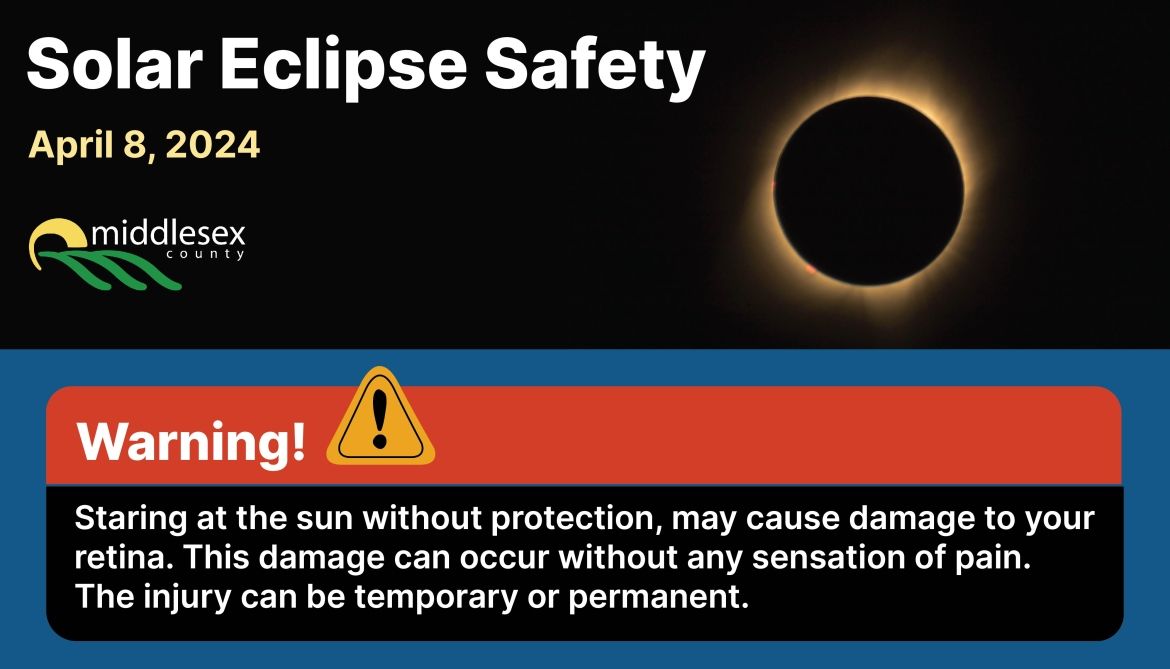
A Total Solar Eclipse will be taking place on Monday, April 8, 2024, visible across North America.
The path of the eclipse will pass through multiple provinces, including Ontario. In the Middlesex-London region, a partial solar eclipse is expected to occur between 2:01 p.m. and 4:29 p.m. with the peak happening at 3:17 p.m., when most of the sun’s light will be covered by the Moon.
Protecting the eyes
It is not safe to look at the Sun without approved eye protection.
Looking at even a small sliver before or after the eclipse without approved eye protection can hurt your eyes and damage your vision. Only glasses or viewers with specialized filters adhering to the ISO 12312-2 international standard can be worn to prevent eye damage from an eclipse.
It is not safe to view an eclipse using:
- regular sunglasses.
- a camera/phone lens, telescope, binoculars, or any other optical device.
- ISO 12312-2 glasses that are damaged, or do not cover the full field of vision.
Remember:
Put on approved glasses/viewers when looking away from the Sun, then look at the eclipse. Look away from the Sun before taking glasses/viewers off.
Precautions are required for the entire duration of the eclipse (2:01 p.m. – 4:29 p.m.).
What could happen?
Looking at the Sun without appropriate protection can lead to serious problems such as:
- Retina burns;
- Blurred vision; and,
- Loss of eyesight
These effects may occur immediately or may not be apparent for 12 to 48 hours.
Seek eye care for:
- a temporary loss of vision,
- blurred vision, or
- loss of eyesight
during or after the eclipse. Call an eye care professional (e.g., optometrist) or health care provider as soon as possible.
Seek emergency care immediately if blindness develops, either immediate or delayed, after viewing the eclipse.
Keeping children safe
- Children should always be supervised during eclipses as they may not understand the risks involved.
- The safety measures you choose to take at your centre will depend on many factors, including, but not limited to:
- Your current policies
- Age and developmental stage of the children in your centre/care
- The characteristics of your physical space
- Where appropriate, talk with the children about Solar Eclipse Safety and involve them in learning and preparation.
Consider different viewing strategies when suitable, such as a LiveStream or an eclipse box, for older children.
Safety Precautions and Considerations:
- Do not look directly at the sun! Do not look indirectly at the sun using a window or mirror reflection.
- Where possible, schedule tasks indoors during the eclipse, to reduce the likelihood of looking at the sun.
- If driving, continue as normal and avoid looking at the sun – depending on the sun position, use hats/ shades/visors that don’t allow any visible light to pass through. Don’t drive wearing eclipse glasses. Have headlights turned on.
- During a solar eclipse, the environment will darken like dawn or dusk – prepare for distracted drivers/people! Where applicable, ensure adequate lighting and wear high visibility clothing appropriate for low light conditions.
- Regular sunglasses are not nearly adequate to protect your eyes while looking directly at the sun. Do not use a camera, a telescope, binoculars, translucent shades/visors, or any other optical device to look at the sun. These devices are not safe for eclipse viewing, and the concentrated solar ray can cause retinal burns.
- If you plan to view the solar eclipse, the use of safe solar eclipse viewers or filters that meet international standard ISO 12312-2 is imperative. If you purchase solar eclipse viewers, please ensure that the viewers are validated and tested by a properly accredited laboratory and meet the requirements of ISO 12312-2.
Resources:
- Build your own projector to watch solar eclipses safely
- Live Stream: Total Solar Eclipse April 8, 2024
- Canadian Association of Optometrists – “How to Enjoy a Solar Eclipse:” infographic
